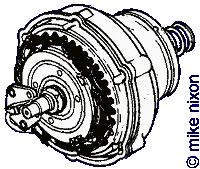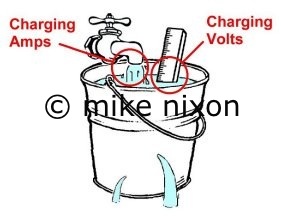  ® ®
|
|
CBX charging system FAQ
CBX charging, part 8
A nine-part series

Q: Why don't you use the official manual's test methods?
A: Two reasons. Most importantly because there is no methodology in the manual. It offers tests but no logic, no troubleshooting path. Second, the tests offered by the manual are the least conclusive type, a fact borne out by the its inevitable recommendation to "replace with known good component." Whatever you call it, that is not troubleshooting.
Q: Why is your method so different from that promoted by other online sources?
A: Simply because other sources are not career mechanics. They do not have more than a half-century of troubleshooting and repairing Honda powersports charging systems. They aren't formally trained, they have not made a living in even one high stress retail repair environment let alone several, and they have not trained other mechanics at the manufacturer level. This is why they trust resistance tests, insert probes the wrong way into canon plugs, disdain dynamic tests, speak against soldering, over-value aftermarket repair parts, over-use thread locker, under-use cordless impacts, and show a marked lack of understanding of how the CBX charging system actually works.
Q: Why do you speak of the rectifier and the regulator as if they were separate parts. Arenít they housed in the same container?
A: Yes, they are contained in the same box, but they have separate functions, and, more importantly, separate operational and thus failure modes. Unfortunately, the unitized construction means that when either fails, they both must be replaced.
Q: You speak of the regulator as a supplying part, when most people assume it to be a limiting part. Can you reconcile this difference in descriptions?
A: Sure. The regulator is both. It is a supplying part in that it supplies energy to the rotor to make it magnetized. But it is also a limiting part in that it monitors battery charge and by that controls how much energy the rotor gets and the resulting system output.
Q: Explain about the alternator drive clutch (coupling) problem you say all CBXs have.
A: Here is a factory Honda engineerís memo outlining the problem. The engine side disc, the memo points out, was mistakenly made dish-shaped instead of flat, meaning that the discs touch only on their outer edges. The result is that the factory's carefully planned percentage of slip between the two discs is hugely multiplied Ė that is, the discs slip ten times as often as they should. These parts are not designed to slip continuously, and they quickly deteriorate. One fix is to simply make the drive disc's contact area flat like it is supposed to be. However, the best fix is to defeat the coupling, that is, make it ineffective.
 -
Q: Why do you insist that charge to the battery be tested in amps and not volts?
A: Volts is not charge. This is pretty important. There is a difference between amps and volts. Imagine a bucket under a water faucet. Water is rushing into the bucket--that's amps. As a result of the water's flow, the level in the bucket rises--that's volts. Which of the two demonstrates activity more clearly? For that matter, is it logical to test discharge and breakeven in amps then charge in volts?
Q: Why must the alternator connector stay connected to check stator output?
A: Because the magnet's (rotor's) wires are in the same connector as the stator's. Disconnecting one disconnects the other. No magnetism, no output.
Q: Arenít some feeler gauges stainless steel and therefore not attracted by the rotorís magnetism?
A: All feeler gauges (except those used in electronic relay work, which are brass) are stainless steel. But itís not the same kind as in your dinnerware, and as such still has a lot of iron in it to be attracted by magnetism. I have never had any trouble getting a magnetic field to attract a feeler gauge.
Q: I have never heard of your way of testing a stator. Why must the stator be loaded, and what is wrong with testing it the way in the official manual?
A: The manual offers a resistance test. Resistance tests are not used by career mechanics. They should never be trusted for making parts purchase decisions.
Q: What is "a 2 ohm, 100 watt resistor," and why is it necessary?
A: This is a so-called "power resistor" often used in experimental radio work, and as such, is easy to find. This resistor is a good test load for stators, as it simulates the bikeís electrical loads very well, yet keeps the stator isolated from the bike for accurate testing. Though inexpensive, it is as effective a test tool as the most sophisticated carbon pile load testers.
Q: How could there still be a problem when the charging system shows there is good charge?
A: Two things are responsible for chronic low batteries, given a good battery to begin with. Either the battery isnít getting enough charge, or itís losing the charge that it gets. One is just as common as the other in charging system diagnosis. So both must be considered.
Q: How does the breakeven rpm test tell you about the loads versus power balance?
A: The CBX discharges its battery at idle. It therefore has an rpm point at which the battery begins to charge--that is, output and input "break even". This breakeven point is supposed to happen at a fairly low rpm (1300 rpm is spec). Higher than normal breakeven, in the face of a tested good battery and a confirmed (tested) good charging system function, therefore indicates an excesssive discharge problem not a charge problem. Discharge versus charge is out of balance.
Q: How can the brake light affect charge?
A: Vintage vehicles like the CBX have fairly low-powered charging systems (the CBX's 350 watts is puny alongside today's 1100-watt and higher systems). As a result, the current going out due to the brake light is rather high compared with the charging current going in. A stuck or misadjusted brake light switch can therefore raise the breakeven rpm so high that at normal road speeds the battery will receive too little charge and get weaker and weaker.
Q: Why do some electrical components draw current even when the keyswitch is turned off?
A: Alarms, radios, clocks, cell phones, GPS--all are are wired directly to the battery, bypassing the keyswitch, because these components have memory and logic circuits that require full-time power.
Q: Why is the static leak test performed at the battery instead of at the fuse terminals like the amps charge and dynamic leak tests? And, why the negative battery terminal?
A: This test must be performed at the battery simply because a leaky rectifier, the most common reason for static leakage (leakage with the key off, remember), would not be picked up at the fuse terminals. As for the negative side, this is for safety. It is the traditional way to avoid the sparks that can result in battery explosions.
Q: What is meant by a "leaky" rectifier?
A: The rectifier has a unique connection in the electrical system. It is the only DC carrying component not controlled by any switches. This connection is potentially troublesome. The rectifier's internal diodes are supposed to permit current flow in one direction only--stator to battery. When the rectifier fails, the battery's current can then reverse-flow into the stator, depleting the battery while the vehicle is parked.
Q: Why doesn't your method include the traditional regulator/rectifier resistance checks?
A: Because "ohmming" the regulator/rectifier is an archaic procedure, and even Honda admits that it rarely works. More importantly, it is unnecessary when using live, dynamic tests such as the key-off discharge test and the amps charge test. For the rectifier side, the best test is a stator output test. If current to the battery is low, but the stator outputs strongly, the rectifier is bad. What could be simpler?
Q: Why is the traditional stator test missing in this method, and why isn't it tested first?
A: The stator is tested dynamically using the load resistor because of the 95/50 Rule. As for not being the first test, Honda CBX stators don't fail very often. Not as often as people think.
Part 9
Last updated June 2025
Email me
www.motorcycleproject.com
My bio
© 1996-2025 Mike Nixon
|
| |